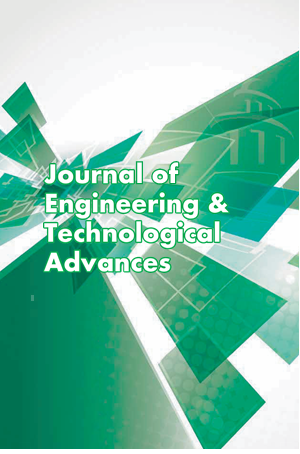Abstract
This study explores the application of difference equations in modelling and analysing electrical circuits, specifically 4-mesh DC, RL, and RLC topologies. With the increasing integration of discrete-time simulation and digital control in engineering systems, traditional methods such as mesh analysis may be limited by computational complexity. Difference equations offer a discrete framework to simulate circuit dynamics using time-stepped recurrence relations. First- and second-order difference equations are applied and derived from RL and RLC circuit models in continuous time using discrete-time approximations. Solution of ladder circuits is through characteristic equation for second-order recurrence relations, whereas recursive formulations are adopted to analyse transient responses in RL and RLC circuits. The study defines complexity in terms of equation count and compares it across methods to demonstrate improved scalability. Realistic component values are selected to reflect conditions in actual electrical systems, such as inductive startup loads and resonant filter behaviour. The resulting current responses demonstrate convergence and system stabilization over time. Stability is confirmed analytically through characteristic roots and time-step considerations. These visualizations reinforce the suitability of difference equations for modelling dynamic responses in power electronics, sensor systems, and digital control applications. The findings highlight how difference equations provide a viable alternative for efficient and scalable analysis in modern electrical engineering.
References
Alexander, C. K., & Sadiku, M. N. O. (2021). Fundamentals of electric circuits (7th ed.). McGraw-Hill. https://www.mheducation.com/highered/product/fundamentals-electric-circuits-alexander-sadiku/M9781260226409.html
Ahmed, I.M., Baraniuk, R., & Sina, A. (2022). 12.8: Difference equations. Engineering LibreTexts. 12.8: Difference Equations - Engineering LibreTexts
Bigelow, T. A. (2020). DC circuit analysis. In Electric circuits, systems, and motors (pp. 43–103). Springer. https://doi.org/10.1007/978-3-030-31355-5_3
Fiore, J. M. (2020). DC electrical circuit analysis: A practical approach. Open Textbook Library. https://open.umn.edu/opentextbooks/textbooks/884
Green, L. (2024). 2.1: Difference equations. Mathematics LibreTexts. https://math.libretexts.org/Bookshelves/Analysis/Supplemental_Modules_(Analysis)/Ordinary_Differential_Equations/2%3A_First_Order_Differential_Equations/2.1%3A_Difference_Equations
Hammond, P. (2020). Lecture notes 7: Dynamic equations part B: Second and higher-order linear difference equations in one variable. Stanford University. https://web.stanford.edu/~hammond/dynEqLects20B.pdf
Kavitha, D., & Raj, F. (2024). Applications of difference equations in enhancement of digital signal processing and reducing signal noise ratio. Journal of Propulsion Technology. https://propulsiontechjournal.com/index.php/journal/article/view/7710
Konjeti, L. P., & Mondal, M. (2023). Difference equations, Z-transforms and resistive ladders. ResearchGate. https://doi.org/10.1080/09747338.2011.10876077
Leydold, J. (2024). Difference equation. Foundations of Mathematics. https://statmath.wu.ac.at/courses/MEC_MM/download/handouts/MMEcon-handouts-18-Difference_Equation.pdf
Piotrowska, E., & Rogowski, K. (2021). Time-domain analysis of fractional electrical circuit containing two ladder elements. Electronics, 10(4), 475. https://doi.org/10.3390/electronics10040475
Presa, A., Hayes, A., Jain, M., Lee, Lin, C., & Khim, J. (2025). Linear recurrence relations. Brilliant.org. https://brilliant.org/wiki/linear-recurrence-relations/
Rahmani-Andebili, M. (2020). DC electrical circuit analysis: Practice problems, methods, and solutions. Springer. https://doi.org/10.1007/978-3-030-50711-4
Salehizadeh, M., & Nouri, H. (2020). Circuit modelling by difference equation: Pedagogical advantages and perspectives. Mathematical Modelling and Engineering Problems, 7(1), 26–30. https://www.iieta.org/journals/mmep/paper/10.18280/mmep.070104?
Sedra, A. S., Smith, K. C., Carusone, T. C., & Gaudet, V. (2020). Microelectronic circuits (8th ed.). Oxford University Press.
Sendov, H. (2020, January 13). First-order difference equations. https://fisher.stats.uwo.ca/faculty/hssendov/FM3613/2020-01-13%20-%20Chapter%205.pdf
Stevic, S. (2024). General solution to a difference equation and the long-term behavior of some of its solutions. Hacettepe Journal of Mathematics and Statistics, 1–19. https://doi.org/10.15672/hujms.1326208
Testbook. (2025). Mesh analysis: Definition, steps to conduct analysis, supermesh & solved problems. Testbook. https://testbook.com/physics/mesh-analysis
The Editors of Encyclopaedia Britannica. (2025). Difference equation | Solution: Recurrence, iteration & solutions. Encyclopedia Britannica. https://www.britannica.com/science/modern-algebra
Weisstein, E. (2025). Difference equation. Wolfram MathWorld. https://mathworld.wolfram.com/DifferenceEquation.htmlhttps://mathworld.wolfram.com/DifferenceEquation.html
Zhang, J. (2023, March 7). System and method for digital-to-analog converter with switched resistor networks. Justia Patents. https://patents.justia.com/patent/20230208426

This work is licensed under a Creative Commons Attribution-NonCommercial-NoDerivatives 4.0 International License.
Copyright (c) 2025 Array

